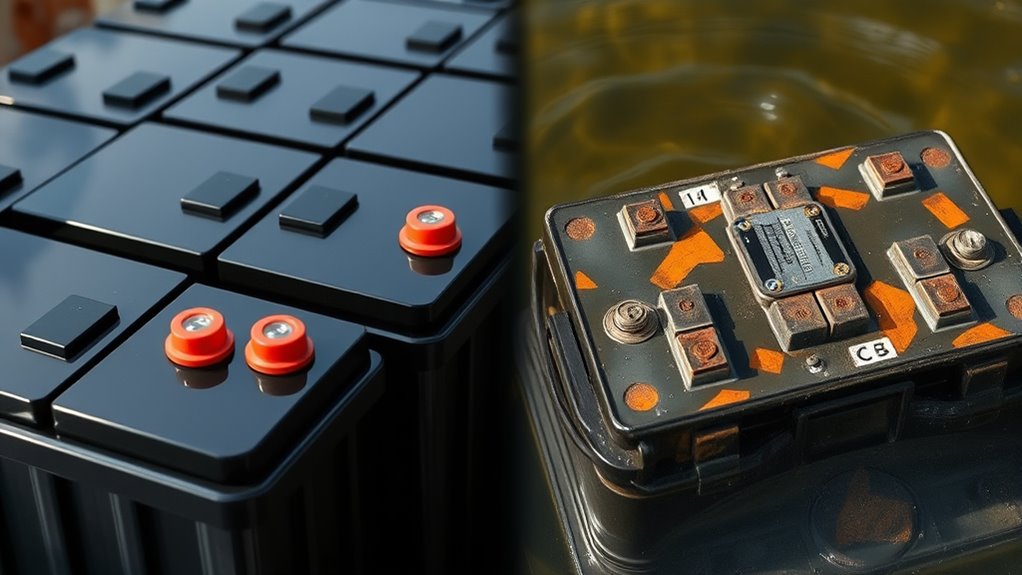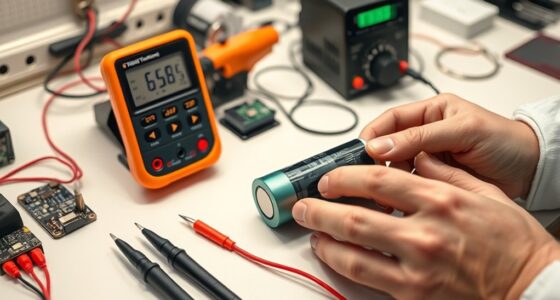When comparing AGM and flooded batteries, you’ll find AGM options are sealed, maintenance-free, and more resistant to vibration and temperature changes, making them ideal for mobile or vehicle use. Flooded batteries, on the other hand, are more affordable upfront but require regular electrolyte checks and proper ventilation. Your choice depends on your application and willingness to perform maintenance. To discover which suits your needs best, explore the key differences and advantages further.
Key Takeaways
- AGM batteries are sealed, maintenance-free, and resistant to vibration, while flooded batteries require regular electrolyte checks and refilling.
- AGM batteries are more expensive upfront but offer longer lifespan and better durability in extreme conditions.
- Flooded batteries need proper ventilation and are more prone to spills and safety hazards during handling.
- AGM batteries are suitable for mobile and high-vibration applications, unlike flooded types that favor fixed setups.
- Choice depends on environmental conditions, maintenance willingness, and budget considerations.

When choosing a battery for your vehicle or renewable energy system, understanding the differences between AGM and flooded batteries is essential. Both types serve similar functions but have distinct characteristics that can impact your performance, maintenance, and installation process. AGM batteries, or Absorbent Glass Mat batteries, are sealed and maintenance-free. They use a fiberglass mat to hold the electrolyte, which prevents spills and allows for a more compact design. Flooded batteries, on the other hand, are traditional lead-acid batteries with liquid electrolyte that needs to be periodically checked and refilled.
If you’re leaning toward AGM batteries, you’ll appreciate their low-maintenance nature. You won’t have to worry about regularly checking electrolyte levels, which makes them ideal for applications where ease of use matters. This feature is especially useful if you’re installing the battery in a location that’s hard to access or if you prefer a cleaner setup without the risk of acid spills. However, keep in mind that AGM batteries tend to have a higher upfront cost. While they might be more expensive initially, their durability and maintenance savings can offset the higher purchase price over time.
Flooded batteries require more active management. Regular battery maintenance involves checking electrolyte levels and topping them off with distilled water as needed. Neglecting this step can lead to reduced lifespan or even damage to the battery. Because of their liquid electrolyte, flooded batteries are more prone to spills and require proper ventilation during installation. This makes placement considerations vital—you need a well-ventilated area that’s protected from extreme temperature fluctuations. Proper installation considerations also include ensuring the correct orientation, securing the battery firmly to prevent movement, and using appropriate safety gear during handling.
While AGM batteries are generally more tolerant of vibration and temperature swings, flooded batteries can be more sensitive, and improper installation may shorten their lifespan. If you’re installing in a vehicle or a mobile setting, AGM batteries often prove to be more resilient, reducing the need for frequent replacements. Conversely, if you’re working with a fixed, well-ventilated setup and are comfortable with routine maintenance, flooded batteries can be a cost-effective choice. Additionally, understanding the city dynamics and environmental conditions of your installation site can influence the longevity and performance of your batteries.
Ultimately, your choice hinges on your specific needs, budget, and willingness to perform maintenance. AGM batteries offer convenience and durability at a higher price point, while flooded batteries provide a traditional, cost-effective solution but demand more active care. Considering these factors will help you select the right battery that aligns with your performance expectations and installation environment.
Frequently Asked Questions
How Long Do AGM and Flooded Batteries Typically Last?
You can expect AGM batteries to last around 3 to 5 years, while flooded batteries typically last 4 to 6 years. Your battery lifespan depends on proper maintenance, with AGM batteries requiring less upkeep than flooded ones. Flooded batteries need regular checks on water levels and cleaning, whereas AGM batteries are more maintenance-free. Taking good care and following recommended maintenance helps extend both types’ lifespan.
Are AGM Batteries More Environmentally Friendly Than Flooded Ones?
Yes, AGM batteries are generally more environmentally friendly than flooded ones. They produce fewer emissions during manufacturing and have safer, more efficient recycling processes. AGM batteries contain less hazardous materials, and their sealed design reduces acid leaks, minimizing environmental risks. Plus, their longer lifespan means fewer replacements and waste. Overall, by choosing AGM batteries, you help lower environmental impact through better recycling options and reduced manufacturing impacts.
Can AGM Batteries Be Used in Extreme Weather Conditions?
In extreme cold, AGM batteries perform well because they’re sealed and resistant to freezing, unlike flooded types that may crack. For example, a skier used an AGM battery in -20°C temperatures, and it maintained steady power. In high heat, AGM batteries also excel since they have lower internal resistance and less risk of leakage. So, yes, you can rely on AGM batteries in both extreme cold and high heat conditions.
What Maintenance Is Required for Flooded Versus AGM Batteries?
You need to regularly check and maintain both flooded and AGM batteries. For flooded types, top off the electrolyte with distilled water and clean terminals to prevent corrosion. AGM batteries require less maintenance but still benefit from corrosion prevention measures. Always recycle your old batteries properly to protect the environment. Regular inspection and maintenance guarantee your batteries perform well and last longer, saving you money and reducing environmental impact.
Which Battery Type Is Better for High-Vibration Environments?
Like a sturdy mountain bike, AGM batteries excel in high-vibration environments. They offer superior vibration resistance and shock absorption, making them ideal when your setup faces constant jolts and shakes. Flooded batteries, by contrast, are more vulnerable to vibrations, which can damage their internal plates. So, if you need reliability in rough conditions, you’ll want to go with AGM batteries—they’re built to handle the bumps and rumbles.
Conclusion
When choosing between AGM and flooded batteries, consider your specific needs. Did you know that AGM batteries last about 30% longer than flooded ones? This makes them a popular choice for those seeking durability and maintenance-free operation. If you want reliable power with less upkeep, AGM might be the way to go. Ultimately, understanding these differences helps you make smarter decisions for your vehicle or backup system.








